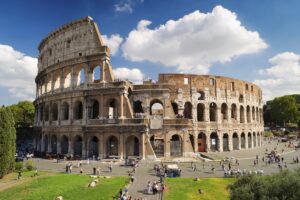While ruins from ancient Rome dot the city, none are perhaps as iconic as the Colosseum. The Colosseum, despite its age and advancements in engineering technology, still holds the record as the largest amphitheater in the world. Seating somewhere between 50,000 and 80,000 spectators, it was the site where important figures of the Roman Empire threw public spectacles that captured the imagination even today. And while it may serve as no more than a symbol today, the weight of its history can be clearly felt on a trip to the ruins today.
Building History
Construction of the Colosseum began somewhere between 70 and 72 CE, during the reign of the emperor Vespasian. The area around the site, a low valley between three of the seven hills of Rome, used to be a very densely populated part of the city until the Great Fire of Rome destroyed much of it in 64 CE. Emperor Nero used this opportunity to seize much of the land for the imperial institution and built a personal estate there, known as the “Golden House” or Domus Aurea. Much of this estate was torn down to make room for the Colosseum, a move which was sure to generate good will among the people who felt angered by Nero’s decision to seize their property.
Use for Public Entertainment
Funded by the spoils taken from the Jewish Temple during the siege of Jerusalem, the initial construction of the Colosseum lasted until 80 CE, and the building was inaugurated with a lavish celebration of gladiatorial combat. According to the historian Cassius Dio, over 9,000 wild animals were slaughtered in just the first set of games alone. Games at the Colosseum were never held by the state directly – they were thrown by private individuals using their own money as a way to demonstrate their power and prestige.
There were several types of games that were thrown at the Colosseum. Gladiatorial combat is the most famous, and these involved combat not just between gladiators and animals, but gladiators and other gladiators as well. Another show popular with the people was the animal hunt – this was different from a gladiatorial contest, involving elaborate set pieces meant to simulate a hunt in the wild. Perhaps the wildest event was the simulated sea battle. The bowl of the Colosseum would be filled with water, and ships would reenact naval battles inside!
Decline
Contests at the Colosseum lasted until well after the fall of the Empire, though they seemed to have stopped around the end of the 6th century CE. The amphitheater was then converted to a cemetery, while the spaces in the arcades under the seating were rented out as housing and studios for artisans. In the 1200s, a Roman family known as the Frangipani took over the building and fortified it to use as a castle. Use of the site for most purposes ended by the middle 14th century, and today the Colosseum serves as one of the most popular tourist attractions in Europe.
Explore the World with AESU!
Are you ready to plan an adventure of a lifetime? AESU offers unique, thrilling travel programs for college students and young professionals at affordable rates. Each trip is action-packed and informal—designed just for people your own age. We are also able to design custom tours just for your group.
Experience an exhilarating adventure in 2023 on the Cosmopolitan, Great Escape, Greek Island Hopper tour, and more! 2023 tour dates are now available! If you have any questions or want help booking your next adventure, please contact AESU by calling 800-638-7640, or fill out the contact form found on our website. Follow AESU on Facebook, Twitter, Instagram, LinkedIn, and Pinterest.

